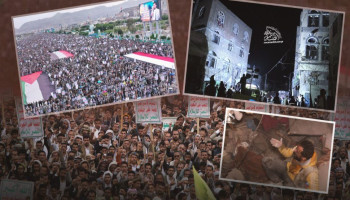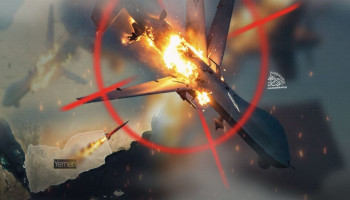The Zionist enemy continues its crimes against the people of the Gaza Strip, with unlimited American support, as the Al-Aqsa Flood battle enters its third week. However, such brutality fails to mask its strategic defeat inflicted on October 7, the scale of which now threatens the occupation entity with a regional war that has begun imposing its equations before officially launching. Its potential seismic ramifications pose a major obstacle to the enemy's main military plans, most notably the plan to invade the Gaza Strip, which the regime and its supporters are increasingly reluctant and hesitant about as indicators and risks of expanding the confrontation at the regional level increase.
Enemy Chokes on Plan to Invade Gaza
Israeli media outlets said: "The occupation army has completed arrangements for a ground offensive on Gaza, but politicians inside the entity still oppose the attack, which the enemy considers the only means of 'responding' to the resounding slap it received on October 7."
The fact is that the issue of a ground offensive on the Gaza Strip has never been about logistics. Even if it was initially, for several days now it has become more related to the fears and ramifications that the Zionist politicians seem to sense day after day. These are concerns related to the situation in Gaza and the region.
Regarding the Gaza Strip, away from the enemy entity leaders' bragging and media propaganda, everyone knows that the ability of the occupation army to carry out a successful ground operation in Gaza is virtually non-existent. This is in light of the results of the historic failure and resounding defeat it suffered with the launch of Al-Aqsa Flood Operation. The situation in Gaza's perimeter settlements remains out of control, and settlers cannot return to them. The mayor of the Sderot settlement, Alon Davidi, stated that there would be no return as long as the Palestinian resistance is present in Gaza.
If this is the situation now, entering Gaza and facing the resistance on its areas would be outright "suicide" for the occupation army, which already relies on reserve recruits with no experience after the entire Gaza Division fell in the resistance's opening attacks.
This is what the Palestinian resistance continues to emphasize through clear messages to the enemy that entering Gaza will be like entering hell!
Outside of Gaza, the enemy faces multiple major concerns that force it to hesitate and recalculate regarding storming the Strip. At the forefront of these concerns is the escalation in the north with Hezbollah, which Israeli media confirms has become a dangerous war of attrition, no longer just skirmishes as some believe. This is especially with the repeated announcements of evacuations of more settlements there. A spokesperson for the occupation army explained that about half a million settlers have been displaced due to what he described as "tensions" with Hezbollah!
The New York Times revealed this week that the United States is also very concerned about the potential for confrontation with Hezbollah to expand. It indicated that Biden and US officials told the occupation entity’s leaders not to “drag” Hezbollah into a major battle, as the Zionist military would not be able to confront on two fronts.
Israeli media outlets confirm that Hezbollah has played a major role since entering the confrontation line in hindering plans to attack Gaza.
Moreover, the Zionist entity and its sponsors' concerns do not stop there, as the threat of regional war persists on other fronts, most notably Yemen and Iraq. Hebrew media outlets on Sunday pointed to estimates in "Israel" of potential attacks and strikes from these two fronts as the battle continues.
Indicators of the Iraqi Islamic Resistance entering the confrontation line have continued to escalate in recent days through intensive, successive attacks on American occupation bases in Iraq and Syria, most recently a drone and missile strike targeting the Ain Al-Assad base on Sunday morning.
US Tries in Vain to Reassure Enemy
Given what various Zionist and American media outlets confirm regarding concerns over expanding the scope of conflict, the enemy’s previous statements about the “long” timeframe of the battle cannot be separated from this. It appears clear that talk of a prolonged confrontation is not so much an “offensive strategy” as it is a desperate attempt to avoid ramifications and find “exits” elsewhere.
Exits that the Zionist entity does not seem to have. Rather, all indicators confirm that the enemy relies entirely on the United States to create an atmosphere for it to attack Gaza without incurring ramifications, especially regional ones.
This is also clearly confirmed by the United States through its continued reinforcement of its presence and forces in the region. On Sunday, US Defense Secretary Lloyd Austin announced that Washington would send more military equipment to the Middle East in support of the Zionist entity, and "to strengthen the defensive position of the United States in the region." He indicated that more air defense equipment would be sent, including THAAD systems to counter high-altitude threats, additional Patriot air defense units, and the deployment of more forces.
As much as this announcement confirms American concern to reassure the Zionist entity, it also reveals that the resistance axis’ messages and warnings have clearly reached Tel Aviv and Washington. It also reveals that the axis has become significantly influential in the equations of Operation Al-Aqsa Flood and is posing an obstacle to the enemy’s rush to implement its criminal plans regarding Gaza.
However, sending more US troops and equipment does not provide real reassurance to the Zionist entity, as fears of wider confrontation are far greater than can be eliminated in this way. Even if the US were to “guarantee” dealing with remote regional risks away from the Zionist entity geographically (which it cannot guarantee), that would not reduce the level and degree of danger the entity faces within the borders of Palestine, whether from Gaza or southern Lebanon.
This clearly explains the ongoing Zionist confusion, reflected in the insistence on attempting to displace Gaza residents and the escalation of massacres there. It appears clear that the enemy wants to exploit the time during which it cannot decide to attack by trying to pressure Gaza’s population and resistance. That does not seem to be yielding any results so far.
These messages serve as valuable advice and evidence, rather than mere displays, for the Saudi regime. They offer an opportunity for the Saudi aggression to learn from past years and make informed choices. With its options and choices significantly reduced due to its aggressive policies and the Yemen blockade, the Saudi regime now faces a crucial decision. It can either acknowledge the legitimate rights of the Yemeni people and surrender, or it can persist in its arrogance and delay until the consequences of its actions force the restoration of those rights. Regardless, there is no alternative but to return what rightfully belongs to Yemen and its people, albeit through different means. The ultimate objective remains the same. The responsibility now rests with Saudi Arabia to decide whether the path ahead leads to peace or war. Time is running out, but there is still a brief window to choose the safer route. Delaying tactics are no longer effective.







